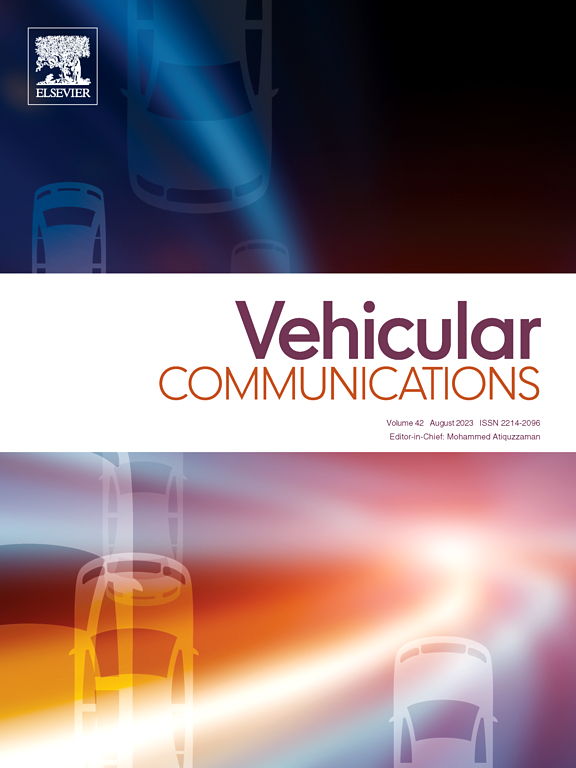A QoS-aware adaptive cross-layer cyber-attack detection algorithm for vehicular networks
IF 6.5
2区 计算机科学
Q1 TELECOMMUNICATIONS
引用次数: 0
Abstract
Securing data transmission and detecting cyber-attacks in consumer Vehicular Ad hoc Networks (VANETs) pose significant challenges due to the highly dynamic topology of the network and frequent mobility of nodes. These characteristics enable attackers to exploit vulnerabilities and evade detection, making real-time attack detection complex while maintaining the Quality of Service (QoS). In this paper, we propose an Adaptive Cross-layer Cyber-attack Detection (ACCD) algorithm that dynamically detects and isolates malicious nodes while optimizing traffic routing based on application-specific requirements. The proposed algorithm uses a cross-layer traffic-aware approach to classify data flows into security-critical and delay-sensitive applications, ensuring optimal routing through the selection of Ant Colony Optimization (ACO) and Ad hoc On-Demand Multipath Distance Vector (AOMDV) protocols. The integration of pre-route authentication (PRA) enhances malicious node isolation, reducing the impact of selective forwarding and blocking attacks. Simulation results show that ACCD achieves lower end-to-end delay and higher Packet Delivery Ratio (PDR) while effectively balancing network security and performance.
一种基于qos感知的自适应跨层网络攻击检测算法
由于网络的高度动态拓扑结构和节点的频繁移动,消费者车辆自组织网络(VANETs)中的数据传输安全和网络攻击检测面临着重大挑战。这些特征使攻击者能够利用漏洞并逃避检测,使实时攻击检测变得复杂,同时保持服务质量(QoS)。在本文中,我们提出了一种自适应跨层网络攻击检测(ACCD)算法,该算法可以动态检测和隔离恶意节点,同时根据特定应用需求优化流量路由。该算法采用跨层流量感知方法将数据流划分为安全关键型和延迟敏感型应用,通过选择蚁群优化(ACO)和Ad hoc按需多路径距离矢量(AOMDV)协议确保最优路由。集成了PRA (pre-route authentication),增强了对恶意节点的隔离,减少了选择性转发和阻断攻击的影响。仿真结果表明,ACCD在有效平衡网络安全和性能的同时,实现了更低的端到端时延和更高的包投递率(PDR)。
本文章由计算机程序翻译,如有差异,请以英文原文为准。
求助全文
约1分钟内获得全文
求助全文
来源期刊

Vehicular Communications
Engineering-Electrical and Electronic Engineering
CiteScore
12.70
自引率
10.40%
发文量
88
审稿时长
62 days
期刊介绍:
Vehicular communications is a growing area of communications between vehicles and including roadside communication infrastructure. Advances in wireless communications are making possible sharing of information through real time communications between vehicles and infrastructure. This has led to applications to increase safety of vehicles and communication between passengers and the Internet. Standardization efforts on vehicular communication are also underway to make vehicular transportation safer, greener and easier.
The aim of the journal is to publish high quality peer–reviewed papers in the area of vehicular communications. The scope encompasses all types of communications involving vehicles, including vehicle–to–vehicle and vehicle–to–infrastructure. The scope includes (but not limited to) the following topics related to vehicular communications:
Vehicle to vehicle and vehicle to infrastructure communications
Channel modelling, modulating and coding
Congestion Control and scalability issues
Protocol design, testing and verification
Routing in vehicular networks
Security issues and countermeasures
Deployment and field testing
Reducing energy consumption and enhancing safety of vehicles
Wireless in–car networks
Data collection and dissemination methods
Mobility and handover issues
Safety and driver assistance applications
UAV
Underwater communications
Autonomous cooperative driving
Social networks
Internet of vehicles
Standardization of protocols.
 求助内容:
求助内容: 应助结果提醒方式:
应助结果提醒方式:


